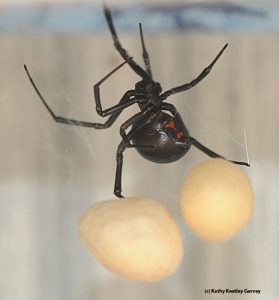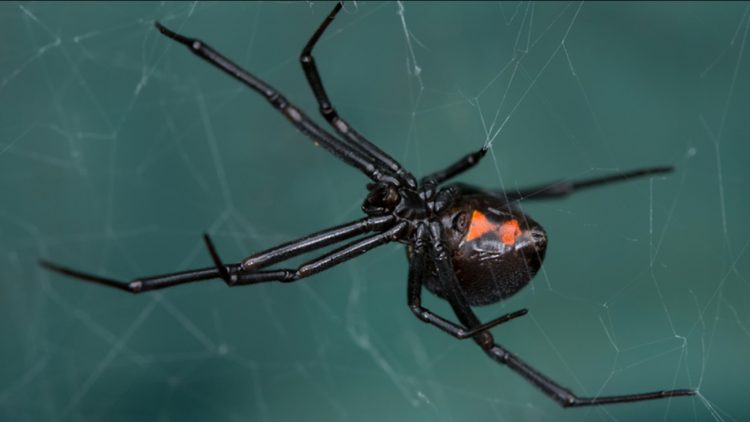What is a black widow and where is it found?
The black widow is one of the most common and venomous spiders in North America. In fact, according to American Association of Poison Control Center, in 2017 there were nearly 2,000 black widow bites reported by in the U.S. And while only a handful were reported as severe, bites can cause severe health concerns up to and including death. Again, these cases are considered rare, but this is not a spider to be trifled with.
Black widows can be found just about anywhere in the country, and they particularly common in Souther Arizona. In Tucson, you’ll find this elusive spider indoors, outdoors, in cold weather, warm weather, and even scorching hot days. Bottom line, black widows are year around threat homeowners need to be aware of, but you’ll need to know what to look out for.
Identifying a Black Widow

We often make the incorrect assumption that everyone knows exactly what a black widow looks like. Some are amongst the lucky few who have never encountered this dangerous arachnid. Here’s a quick description of what to look out for: The female black widow spider (Latrodectus hesperus) is easy to distinguish. About half an inch long and shiny jet black, she’s characterized by a red hourglass pattern on the underside of her bulbous abdomen. But don’t bet on the pattern or coloring. Some black widows have a fragmented pattern, and some display no hourglass pattern or no red coloration at all.
Web
The thing that strikes most people about black widow webs is how chaotic they appear. There isn’t a discernible pattern at first glance. Rather, it appears haphazard, tangled and crisscrossed. It’s also typically constructed close to the ground. Because of this location and the strength of the black widow’s silk, leaves and other debris will often get tangled in the widow’s web. The silk is so strong, if you waved your hand through it, you’d hear it rip. So strong in fact, in World War II, black widow silk was used to make crosshairs for gun sights.
Eggs
 Egg sacs are white, tan, or gray in color, have a paper-like texture, and measure 12 to 15 mm in diameter. They may be pear-shaped or globular. Each egg sac contains hundreds of eggs, from which hundreds of spiderlings emerge. However, only a handful of these young survive, as black widows are cannibalistic during the early stages of their lives.
Egg sacs are white, tan, or gray in color, have a paper-like texture, and measure 12 to 15 mm in diameter. They may be pear-shaped or globular. Each egg sac contains hundreds of eggs, from which hundreds of spiderlings emerge. However, only a handful of these young survive, as black widows are cannibalistic during the early stages of their lives.
Black widow eggs can be found in dark crevices beneath stones and in natural debris such as woodpiles. Barns and other secondary buildings are likely to host these spiders, as well. Black widow spider eggs may also be deposited within neglected materials or animal and rodent nests.
Now that you know what to look for, here’s a few tips on how to avoid black widows altogether:
1. Take Away Opportunity
So much of pest prevention is about limiting opportunity. Black widows are rarely found out in the open. Instead, they prefer hiding and setting up their webs in dark, cool places. To help keep your home free of black widow spiders, minimize hiding spots around your home. For example, eliminate non-essential outdoor items and yard debris. Keeping storage containers sealed and avoiding clutter in the garage are going to eliminate some of their favorite hiding places.
2. Inspect Firewood and Other Outdoor Materials
We’ve talked previously about how important it is to inspect firewood during the winter months. The truth is, if any tool, toy, piece of furniture, or foliage not indoors has the potential to be a home for unwanted pests. Black widows are ready to pounce on just about any opportunity, but they are most active at night. So, a good rule of thumb, if something has spent the night outdoors or in the garage overnight, thoroughly inspect it before using.
3. Dust and Vacuum Regularly
This is about more than being clean. Rather, this tip is complimentary to the first one, taking away opportunity. If black widows do end up in your home, they will typically set up webs and egg sacs anywhere they feel hidden and secure, such as underneath furniture, in the corners of rooms, beneath windowsills, etc. Dust and vacuum these areas regularly to get rid of any black widow egg sacs and spider webs.
4. Schedule Regular Maintenance
Finally, and most importantly, schedule regular maintenance. Pest Management professionals pay particularly close attention to pests that pose an actual danger to the residents. Regularly scheduling a pest management service assures two things: 1.) You avoid any gaps in service. Spiders and other pests are ready to move in the moment the pesticides are no longer effective. Scheduling regular service ensures there is no down time. 2.) A good pest management professional has been servicing Tucson homes for years. This means, they know exactly what to look for and where to apply Pest Management measures. A deep familiarity with the habits and measures that are effective against black widows is critical.






